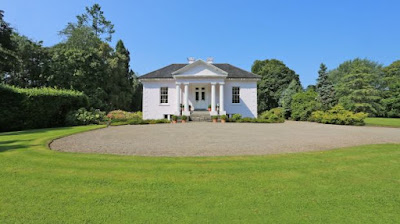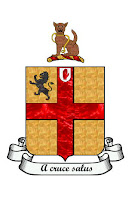This is one of the families that settled in Ireland under the banner of Richard de Clare, 2nd Earl of Pembroke, nicknamed Strongbow, and is supposed to have branched from the parent stock of the illustrious house of CLANRICARDE.
It may not be irrelevant to observe that all the French families of the name continued to write it De Bourg, and in Latin, De Burgo; and that after the De Burghs removed from Normandy into England, they also wrote De Burgo, and sometimes De Burgh, in order to accommodate the word to the English or Saxon accent.
However, in process of time, they wrote Bourk, Bourke, and Burke; but the King, by letters patent, in 1752, granted to the Earl of Clanricarde, to Ulick Bourke, of London, and to Thomas Bourke, of Ireland, and their descendants, full authority to resume the original surname of De Burgh.
RICHARD BOURKE, of Dromsally, County Limerick, died in 1764, and was succeeded by his eldest son,
RICHARD BOURKE, of Dromsally, who was succeeded by his eldest son,
RICHARD BOURKE, of Castle Connell, who assumed the original name of De Burgo, and was created a baronet in 1785, designated of Castle Conel [sic].
Sir Richard, High Sheriff of County Limerick, 1758, married firstly, in 1755, Frances, eldest daughter of David Webb, of Meadstown, County Limerick, and had issue, two daughters,
Frances; Maria Theresa.
He wedded secondly, in 1781, Elizabeth, daughter of Anthony Dwyer, of Singleton, County Limerick, by whom he left two sons; and dying in 1790, was succeeded by the elder,
SIR RICHARD DE BURGO, 2nd Baronet (c1783-c1808), at whose decease unmarried the title devolved upon his only brother,
SIR JOHN ALLEN DE BURGO, 3rd Baronet, of Castle Connell, who espoused firstly Miss Hall, sister of General Gage John Hall, but by her had no issue; and secondly, in 1820, Anna Matilda, daughter of Richard Waller, of Castle Waller, County Tipperary, and had issue,
RICHARD DONELLAN, his successor;William Henry Frederick Waller, dsp.
Sir John died in 1839, and was succeeded by his elder son,
SIR RICHARD DONELLAN DE BURGO, 4th Baronet (1821-73), of Castle Connell, who married, in 1844, Catherine, youngest daughter of Brooke Brasier, of Rivers, County Limerick, and Mitchell's Fort, County Cork.
Sir Richard died without issue, when the baronetcy expired.
 |
| Castle Connell (Robert French/NLI) |
Castle Connell, picturesquely situated on a rock overlooking the River Shannon, about six miles north of Limerick, became the principal castle of the Bourkes in West Clanwilliam.
The ruinous castle, erected on a rocky outcrop overlooking the bend on the River Shannon, was besieged and destroyed by General Ginkel’s army during the Jacobite and Williamite wars at the end of the 17th century.
 |
| Island House (Image: The Irish Times, 2022) |
Island House, Cloon Island, near Castleconnell, was built ca 1840 by Sir John Allen De Burgo, 3rd Baronet.
 |
| Island House, Cloon Island (The Irish Times, 2022) |
The Rev Canon Patrick Comerford wrote an article about Island House in 2017.
De Burgo arms courtesy of European Heraldry.



No comments :
Post a Comment